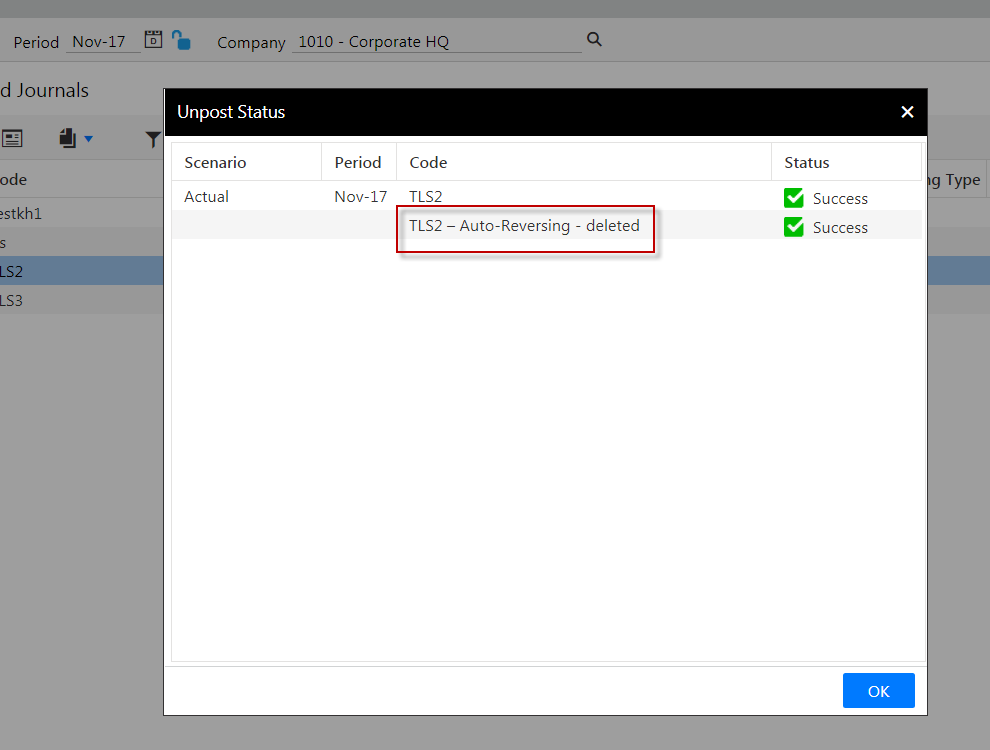- 10 Minutes to read
- Print
- DarkLight
- PDF
Standard Journals
- 10 Minutes to read
- Print
- DarkLight
- PDF
When Should I Add a Standard Journal and How is it Done
Add a Standard Journal when you have to post a journal entry for only one time.
In the Consolidation Control Panel, under Processes, click Standard Journals. The Standard Journal grid appears.
Click Add. The Add Standard Journal dialog appears.
Enter a code of your choice in the Code field.
Enter a name for the Standard Journal in the Name field.
Select the month and year range in the Period field. During the selected time period, the journal is active.
YTD displays for the journal Posting Type.
Note:MTD (month to date) evaluates entries based on the month’s activity; whereas YTD (year to date) evaluates the entries based on the cumulative balance for the line items.Select Adjustments (CC) or Adjustments (LC) in the Reporting drop-down list. A journal can be in common currency or local currency.
Note:A local currency is often used by a company's subsidiaries and then converted to a common currency for consolidated reporting purposes.Select the Auto-Reversing checkbox to create a Standard Journal Entry with an Auto-Reversing entry in the subsequent period. The originating entry is the base entry in the current period to configure the Auto-Reverse option.
The Auto-Reversing entry is a replica of the originating entry, but applicable for the subsequent period. For example, you can use this feature to close books for a given month (accrue vacation liability), which will be reversed in the subsequent month once the more relevant information is known about the actual cost associated with the entry.
When the originating entry is posted, the Auto-Reversing entry is created. For example, if you post the originating entry in Jan-2019, the Auto-Reversing entry will be posted in Feb-2019.
In the grid that displays segment columns based on the application configuration and user's security, set up a journal entry by performing the following steps:
Click Add Row. A new row is added.
Do one of the following to set up the values for each column:
Complete the values in the UI directly, by either typing the values or selecting the value.
Paste copied line items from an Excel spreadsheet to the journal entry grid. You can copy/paste all values, including descriptions, segments, and debit/credit values. Use shortcut keys (Ctrl+C and Ctrl+V).
- The Total displays the Debit or Credit amount for the entire column as well as the running variance column.
- Click Save. The journal entry is added.
How to Upload Standard Journals
Upload Standard Journals in xlsx format directly to the Consolidation module. Use the sample template (that you can download) for ease of use when performing the upload.
In Practice: How to Download the Sample Template
Access the Consolidation module.
Click the Standard Journals process.
Click the Upload icon shown below. The Standard Journals Upload dialog appears. Click Download sample Excel template.
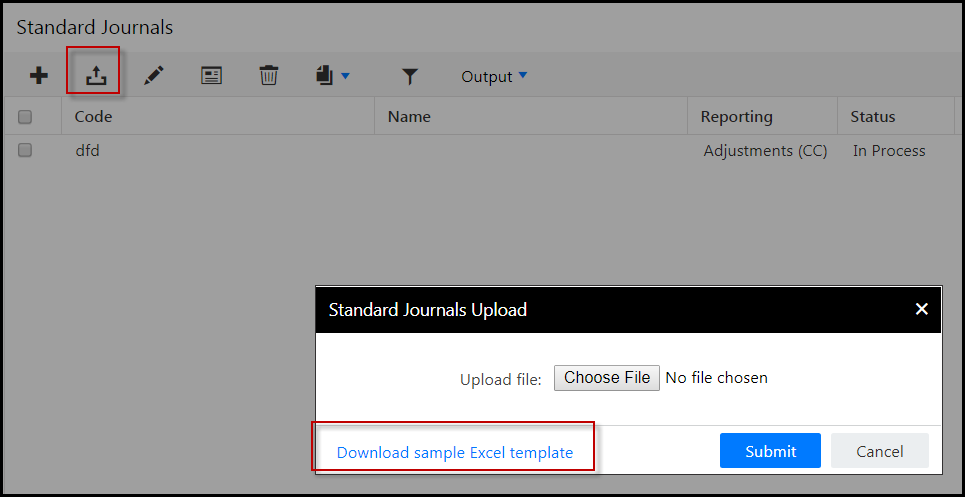
In Practice: Uploading Standard Journals (with Failed and Completed Examples)
Access the Consolidation module.
Click the Standard Journals process. Standard Journals appear in the center pane as shown below.

If no Standard Journals were created or uploaded then this pane will be blank. You can opt to upload or enter journals or do a medley of both. Click the Upload icon shown below.

When you click the Upload icon, the Standard Journals Upload dialog appears. It is best practice to use the sample Excel template as it instructs you exactly how to organize your journal data to load it successfully. Click Download sample Excel template.
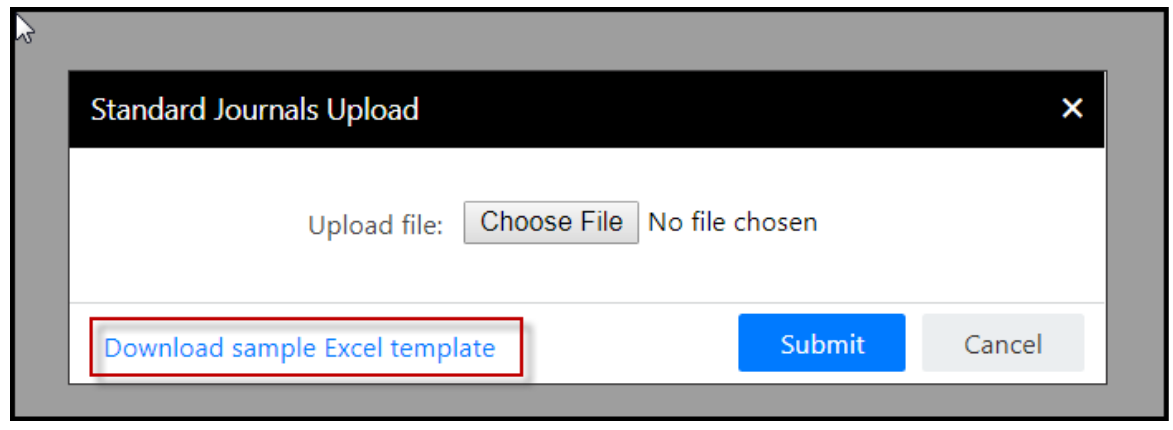
The template is downloaded to your computer. Open the template.
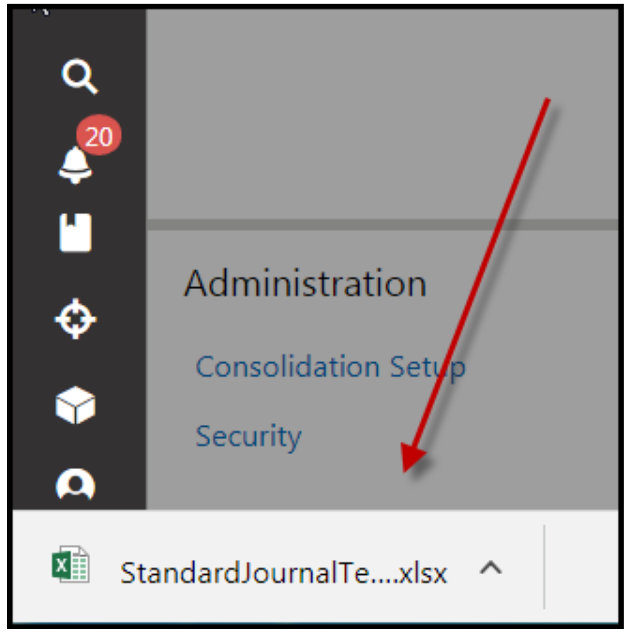
The template displays and indicates the required fields. It also provides information to ensure the correct data is entered where needed. Copy and paste the template into a new file.
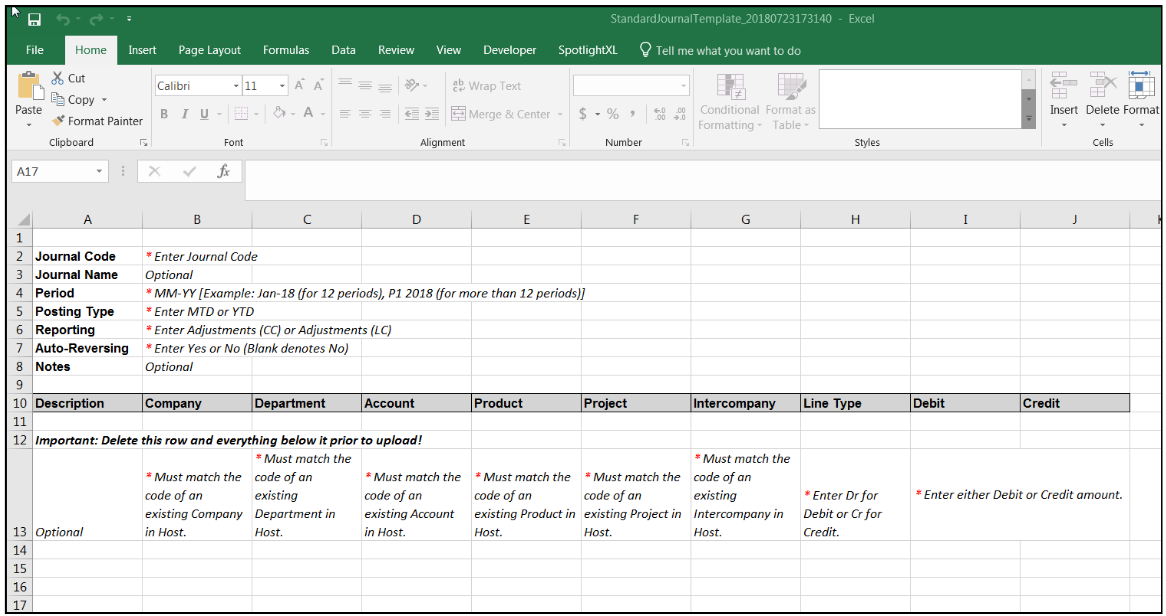
Enter a journal code, the period for which you want to load the journals, and the posting type as shown below.
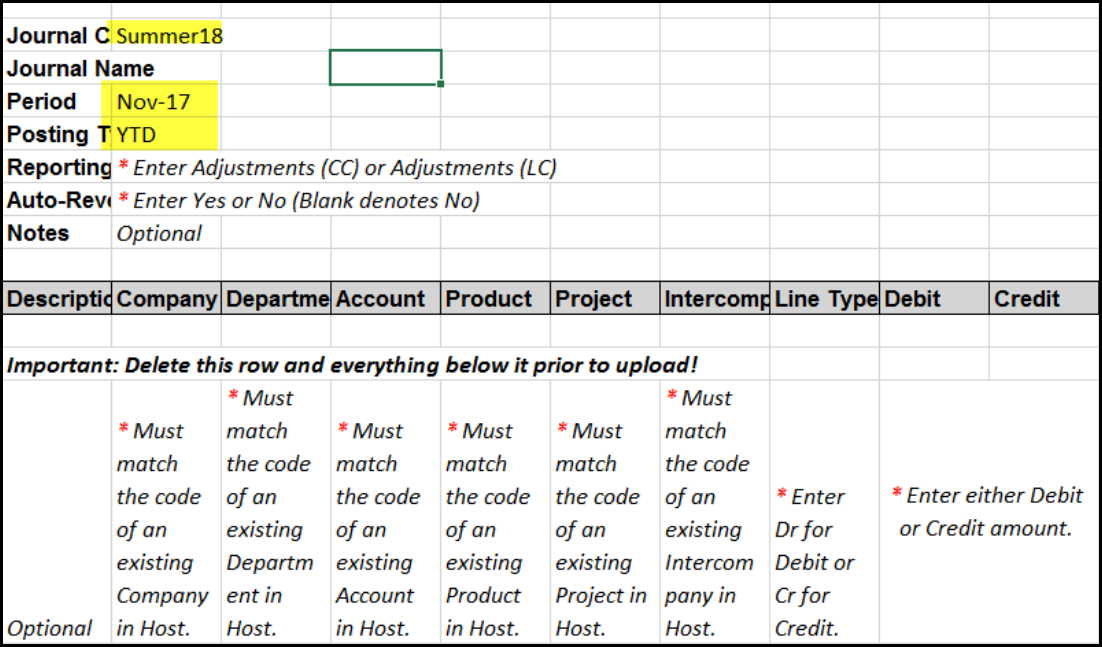
Enter Adjustments (CC) or Adjustments (LC) for reporting, Yes or No for auto-reversing and enter notes as needed.
Now, you’re ready to copy and paste journals to the spreadsheet. Notice how the grid names in the Excel template match the names within the application Journal Add page. Prior to copying and pasting data to the Excel file, make sure you delete all the tips located in the sample file.
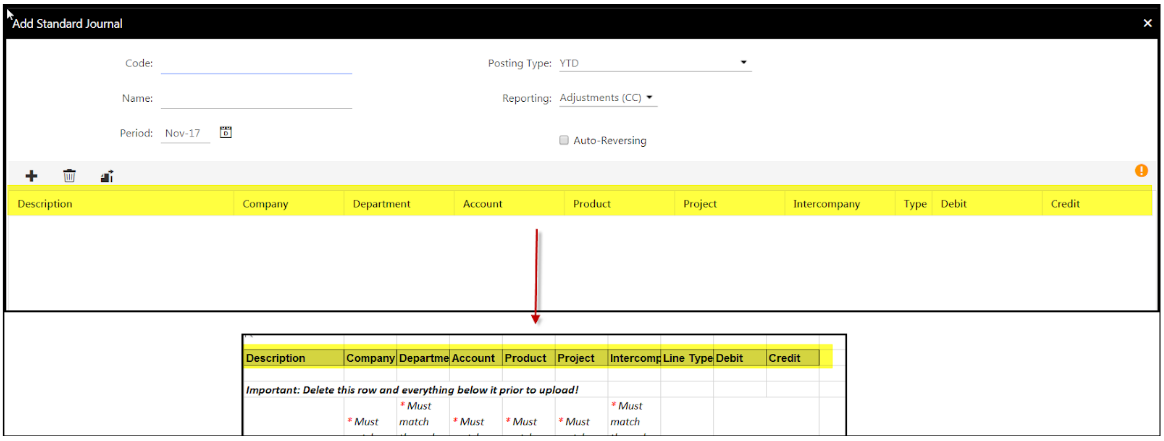

Save the xlsx file to your computer.
Click Choose File.
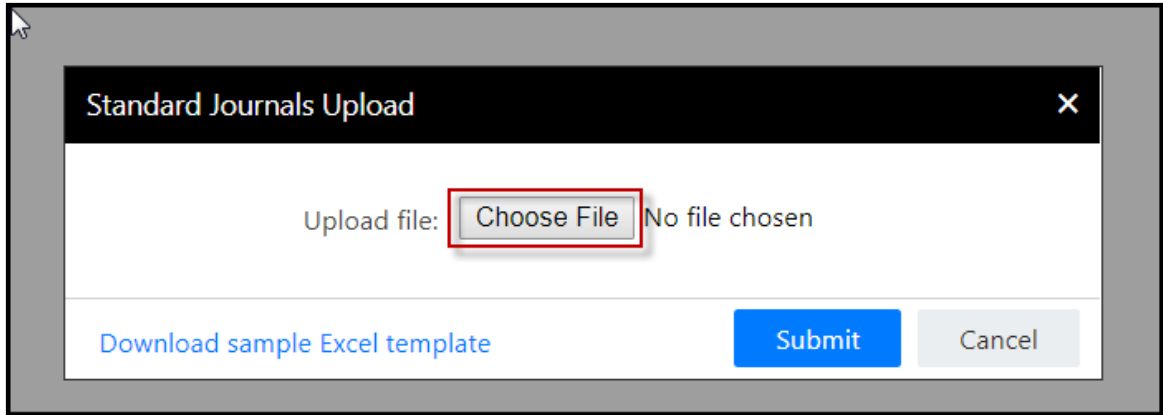
Select the file you just saved to your computer.
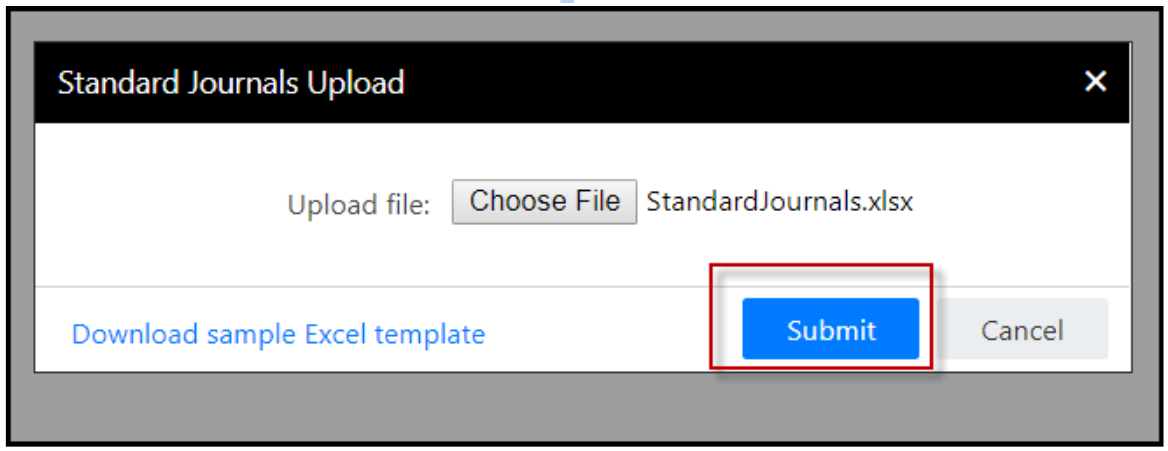
Click Submit to perform the upload. A message will appear once submitted (as well as once the upload is complete) where you can click through to the Detail View (shown below) to view the status of the upload. Additionally, clicking Submit will create a Job Manager process called Standard Journals Upload (also shown below).
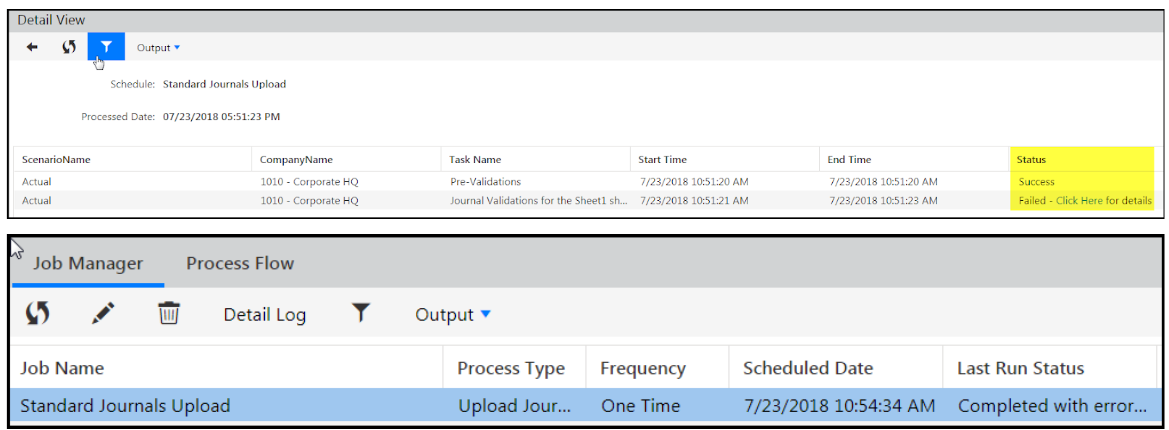
If the upload failed, click the Status field link (Click Here ) to download an Excel file with information on why the failure occurred. An example of a failed upload is shown below. Fix the errors and upload the file again.
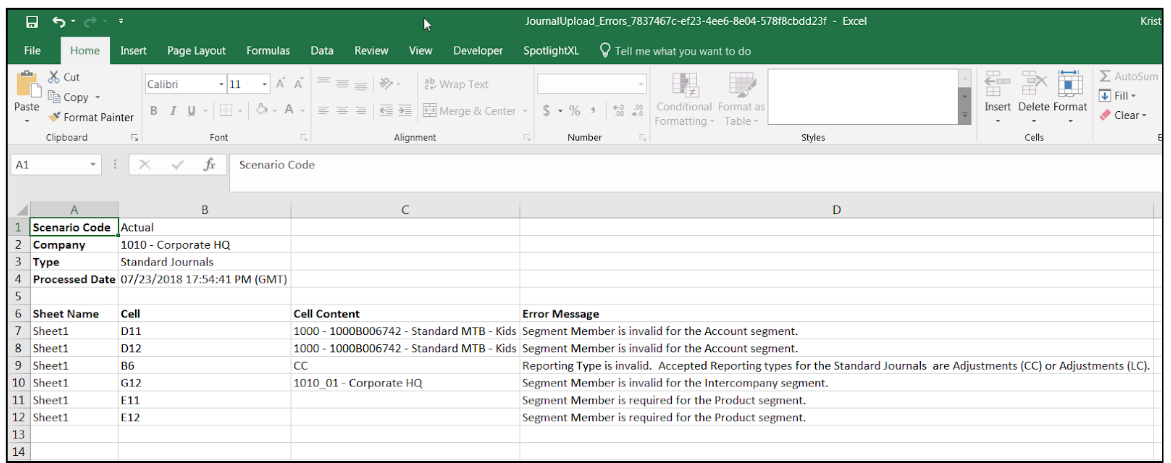
Once journals are uploaded successfully, the Detail View will display Success in the Status field and the uploaded Standard Journal will display in the Consolidation Control Panel (shown below).


How to Copy an Existing Standard Journal within the Same Scenario
Use an existing Standard Journal to create a copy with new criteria for posting entries. Doing so saves time.
In the Consolidation Control Panel, under Processes, click Standard Journals. The Standard Journals grid appears.
Select the journal you want to copy.
Click Copy and select Copy Single. The Copy Standard Journal dialog appears.
Click Save.
How to Copy a Standard Journal from One Scenario to Another
Access the Consolidation Control Panel.
Select the scenario you want to copy the journals from.
Select the Standard Journal process.
Click the checkbox next to the entry you want to copy.
Click the Copy icon. Select Copy Multiple . The Copy page appears.
Enter a Code and Name and select period dates.
Select the Target Scenario .
Complete all selections based on process being copied.
Click Save.
If you select multiple entries to copy, the Copy Single option will not be available.
Best Practice when Copying Standard Journals
Limit the number of journals and journal lines you copy to a combined total of 30,000 (journals + lines). For example, 1000 journals with no more than 30 lines. Or, 60 journals; each of which has no more than 500 lines.
How to Edit a Standard Journal
You may want to edit a Standard Journal to add, edit, or delete existing entries, prior to posting entries. You may or may not be able to edit a journal based on the status. For example, you can't edit a journal that is Approved. You can edit a journal that is In Process.
Edit button available because the journal is In Process:

Edit button not available:

In Practice
In the Consolidation Control Panel, under Processes, click Standard Journals. The Standard Journals grid appears.
Select the Standard Journal you want to edit.
Click Edit. The Edit Standard Journal dialog appears. Edit as necessary.
Click Save to save the changes and exit the Edit Standard Journal dialog.
When and How to Delete a Standard Journal
You may want to delete unused or inactive Standard Journal lines. When you delete a Standard Journal line, all the associated journal entries are also deleted. You can select many Standard Journal lines at once and delete them. To do so, click the checkbox in the column header to select all Standard Journal Entries.

In Practice
In the Consolidation Control Panel, under Processes, click Standard Journals. The Standard Journal grid appears.
Select the Standard Journal line you want to delete. Or select to delete all lines.
Click Delete.
In the confirmation dialog that appears, click OK.
When and How to Forward a Standard Journal

In Practice
In the Consolidation Control Panel, under Processes, click Standard Journals. The Standard Journals grid appears.
Select the journal with an In Process status.

Under Entry Actions, click Forward. The journal enters the Pending Review status. The application sends out notification to the user about the review action for assigned journal entry.

When and How to Approve a Standard Journal
Approve journal entries that are correct and complete. This action is available for journals with a Pending Review status only. An approved journal entry is ready for posting.
In Practice
In the Consolidation Control Panel, under Processes, click Standard Journals. The Standard Journals grid appears.
Select the journal with a Pending Review status.
Under Entry Actions, click Approve. The journal enters the Approved status.

When and How to Reject a Standard Journal
Standard Journals that you want to skip from posting before they are approved can be rejected.

In Practice
In the Consolidation Control Panel, under Processes, click Standard Journals. The Standard Journals grid appears.
Select the journal with a Pending Review status.
Under Entry Actions, click Reject. The journal entry enters the Rejected status.
When and How to Return a Rejected Journal to an In Process State
A rejected Standard Journal may need to complete the full lifecycle to ensure audit ability. You can edit rejected journals, return them to an In Process state, and have them approved.
In Practice
Follow the steps below to return a rejected Standard Journal to an In Process state.
Access the Consolidation Control Panel.
Select the Standard Journals Process.
In the center pane, all journals are displayed. Select the rejected Standard Journal you want to return to an In Process state.
Click the In Process action.
When and How to Post a Standard Journal
After all the journal entries are posted successfully, no actions are available inside the Entry Actions pane.
In Practice
In the Consolidation Control Panel, under Processes, click Standard Journals. The Standard Journals grid appears.
Select the approved Standard Journal entry that you want to Post.
Under the Entry Actions, click Post. The Post Status dialog box appears. The Status column displays Success if the journal entry is posted successfully. Otherwise, the Status column displays Failure.
Click OK to exit the Post Status dialog. The Standard Journal status is changed to Posted.
What Happens When I Post an Auto-Reversing Journal
When adding a Standard Journal, if you select the Auto-Reversing option for an originating entry, the Post process creates an Auto-Reversing entry in the Approved state.

If the posting of an originating entry fails, the Auto-Reversion entry will not be created in the subsequent period.
When posting a journal with the Auto-Reversing option, the Post Status dialog indicates whether the Auto-Reversing entry is successfully created.
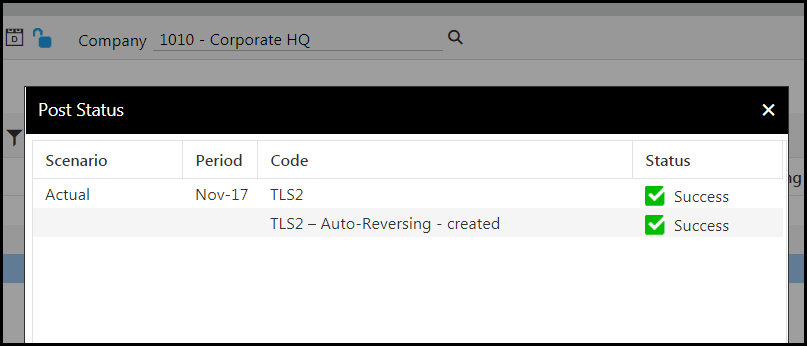
If the originating entry is posted for the last period, you can not create the Auto-Reversing entry until you extend all your application periods. This is done by accessing the Configuration Tasks ( Maintenance > Admin > Configuration Tasks ) page.
If you post the originating entry for the last fiscal period of a year, you will receive an alert indicating that you are about to create an auto-reversing entry in the next fiscal year.
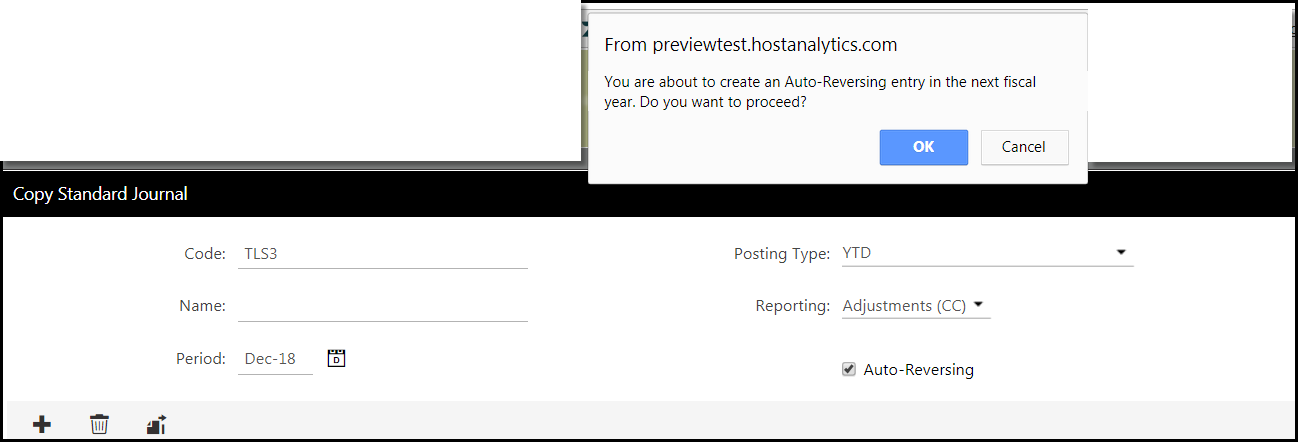
If an Auto-Reversing Journal entry fails to post properly, it remains in an Approved state until you resolve the issue and perform the Post action again.
How to Unpost a Standard Journal
Posted journals with a current period or prior period can be unposted. When a journal entry is unposted, a message appears indicating whether the unpost was successful. If a journal entry unpost fails, hover over the Failure Status to determine the reason for the error. A journal entry that has been unposted successfully will enter the Unposted status, and the In Process action is available inside the Entry Action pane. You can rework on the unposted journal entries by clicking the In process action and forwarding them after making the necessary changes.
In Practice
In the Consolidation Control Panel, under Processes, click Standard Journals. The Standard Journals grid appears.
Select the posted Standard Journal, under Entry Actions, click Unpost.

The Unpost Status dialog appears. The Status column displays the unpost result for the Standard Journal. The Success status is shown if the journal entry is unposted successfully.
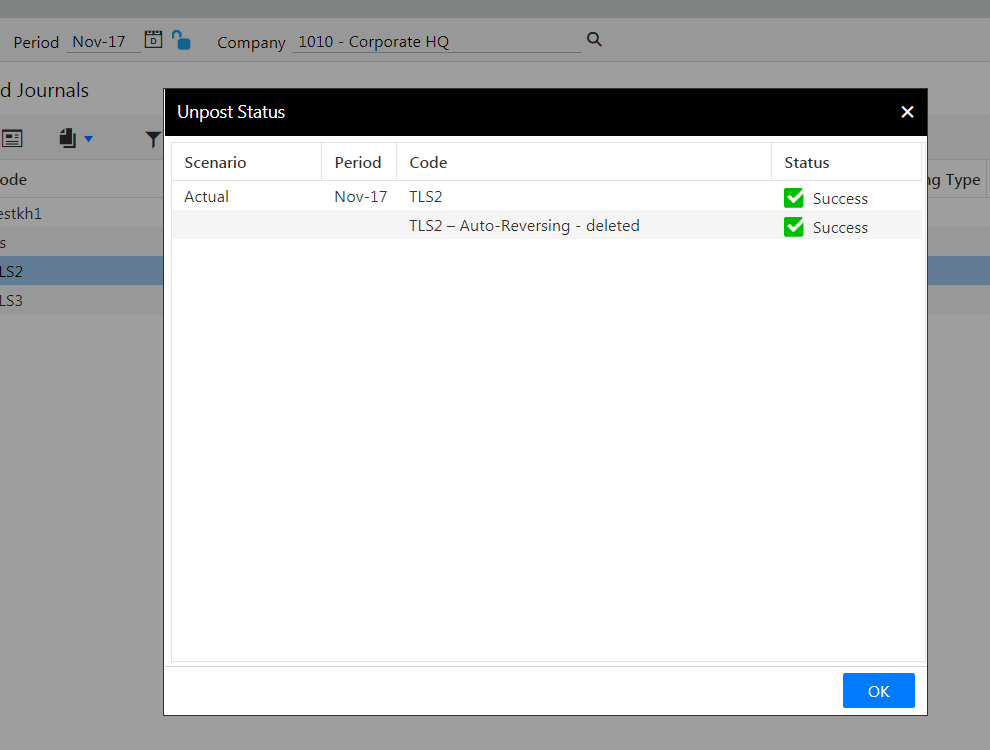
How to Unpost an Auto-Reversing Journal
Posted originating Auto-Reversing Standard Journals can be unposted. When unposting a journal with the Auto-Reversing option, the Auto-Reversing entry is unposted and deleted. The procedure to unpost an Auto-Reversing entry is the same as an originating entry.
